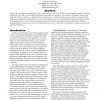Free Online Productivity Tools
i2Speak
i2Symbol
i2OCR
iTex2Img
iWeb2Print
iWeb2Shot
i2Type
iPdf2Split
iPdf2Merge
i2Bopomofo
i2Arabic
i2Style
i2Image
i2PDF
iLatex2Rtf
Sci2ools
CMG
2003
2003
Virtual Memory Constraints in 32-bit Windows
Many server workloads can exhaust the 32-bit virtual address space in the Windows server operating systems. Machines configured with 2 GB or more of RAM installed are particularly vulnerable to this condition. This paper discusses the signs that indicate a machine is suffering from a virtual memory constraint. It also discusses options to keep this from happening, including (1) changing the way 32-bit virtual address spaces are partitioned into private and shared ranges, (2) settings that govern the size of system memory pools, (3) hardware that supports 36-bit addressing. Ultimately, running Windows on 64-bit processors is the safest and surest way to relieve the virtual memory constraints associated with 32-bit Windows.
32-bit Virtual Address | CMG 2003 | CMG 2007 | Virtual Address Spaces | Virtual Memory Constraints |
| Added | 31 Oct 2010 |
| Updated | 31 Oct 2010 |
| Type | Conference |
| Year | 2003 |
| Where | CMG |
| Authors | Mark B. Friedman |
Comments (0)

